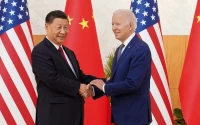So, a grainy video pops up online. You know the type—the kind that looks like it was filmed on a potato in a poorly lit basement. In it, some commander from Lashkar-e-Taiba, a guy named Saifullah Saif, is basically shouting into a microphone that his boss, Hafiz Saeed, is "not sitting idle." He’s apparently "preparing to attack India through Bangladesh."
Give me a break. "Not sitting idle" is the understatement of the century for a guy like Saeed, the alleged architect of the Mumbai attacks. That’s his entire job description. It’s like saying a shark is "not sitting idle" in the water. What else is it supposed to do?
The clip, which offcourse hasn't been independently verified because these things never are, has everyone wringing their hands. It’s the perfect little nugget of digital fear-mongering, tailor-made to go viral and get the cable news anchors all worked up. And honestly, I’m less concerned about the video itself than the fact that we’re all supposed to act shocked by it. Are we really pretending this is some bolt from the blue?
A Conveniently Timed Reunion
Let’s connect the dots here, because the people in charge seem to be using crayons. This conveniently timed threat doesn't happen in a vacuum. It drops right as Pakistan and Bangladesh are getting cozy for the first time in decades.
We had Pakistan’s Navy chief pop over to Dhaka for a four-day visit. A Pakistani warship docked at the Chattogram port—the first time that’s happened since 1971, a year loaded with more historical baggage than a U-Haul truck. This is all happening after the fall of Sheikh Hasina’s government, a shift that clearly has the folks in New Delhi sweating.
This is a bad development. No, "bad" doesn't cover it—this is a five-alarm dumpster fire of diplomatic negligence. You don't need a PhD in international relations to see what’s happening. Pakistan, feeling squeezed, is looking for new friends and new pressure points. Bangladesh, under a new regime, is signaling it’s open for business. And India is stuck in the middle, watching its strategic backyard turn into a potential staging ground for its oldest enemies.

The whole thing feels like watching a slow-motion game of geopolitical Jenga. For years, the tower of regional stability, rickety as it was, stood. Now, you have Pakistan and Bangladesh pulling out blocks with these high-profile visits and military handshakes. Each move is presented as a step towards "cooperation," but everyone holding their breath knows it’s just making the whole structure weaker. The question isn't if it will fall, but who gets blamed when it does. Will Bangladesh become a launchpad for anti-India activities? What does "closer" even mean in this context? A few photo-ops and a naval visit, or something much more tangible being built just out of sight?
The Echo Chamber of Threats
The language in that video clip is almost comically villainous. The commander claims LeT operatives are already in "East Pakistan"—a name that hasn't been used in 50 years and is a deliberate, calculated insult—and are ready to "answer India for Operation Sindoor." It’s pure theater, designed to provoke.
And it’s working. We’re told Saeed sent an associate to Bangladesh to incite local youth and provide "terror training." It's the classic playbook, chapter one. Find a place with political instability, whip up some ideological fervor, and hand out weapons. I’m not saying it isn’t dangerous—it absolutely is. But it’s also painfully, depressingly predictable.
This isn't some 4D chess move. It's a blunt instrument. It's the geopolitical equivalent of a drunk guy at a bar puffing out his chest and looking for a fight. The problem is, when nations do it, the bar is an entire subcontinent armed with nuclear weapons.
I keep wondering what the actual conversations are like behind closed doors. Are these leaders just reacting, or is there a strategy here beyond poking the hornet's nest? Maybe I’m the crazy one, but I feel like we’re all watching a prequel to a movie we’ve already seen a dozen times. And the ending is never a surprise.
So, We're Just Doing This Again?
Look, let's be real. This isn't a "new front." It's the same old war, just with a change of scenery. It's a tired, toxic rivalry finding a new patch of dirt to fight on. The names, dates, and locations change, but the script is identical. We’re supposed to analyze the naval visits and parse the rhetoric from some low-level militant as if it’s a complex puzzle. It ain't. It's a depressingly simple equation of power, instability, and old hatreds finding new life. And the most infuriating part is that we'll all be forced to watch it play out, again.










